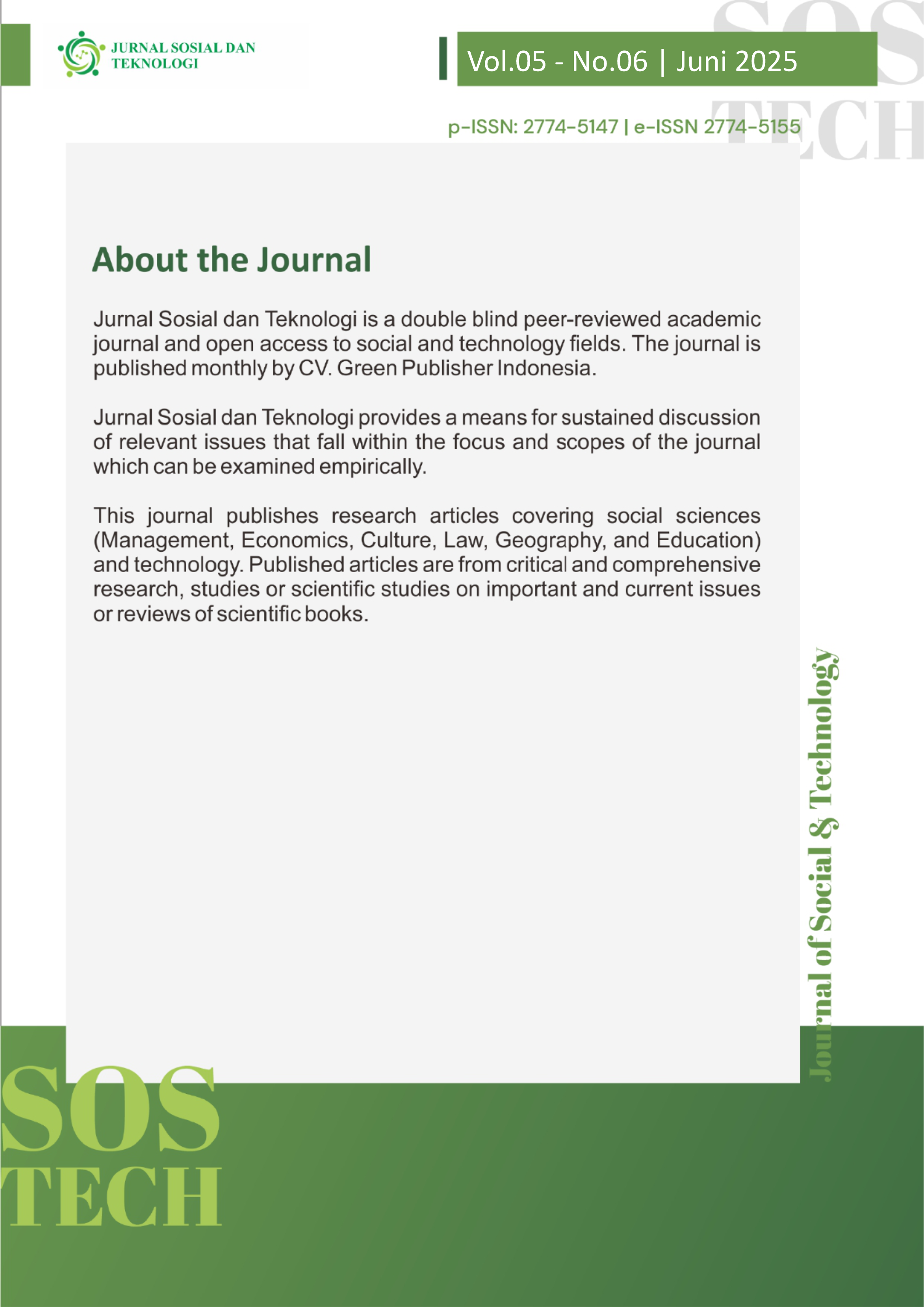Engineering Behaviour of Clay Shale Stabilized with Asphalt Emulsion and Artificial Lightweight Aggregate Perlite
DOI:
https://doi.org/10.59188/jurnalsostech.v5i6.32213Keywords:
Clay Shale, Soil Stabilization, Asphalt Emulsion, Artificial Light Weight Aggregate PerliteAbstract
Soil plays a vital role in the planning stage of road construction. The subgrade, representing the final construction that receives the vehicle load transmitted by the pavement, is of critical importance. Clay shale is among the most challenging soil types due to its susceptibility to weathering when exposed to water or air. In the wake of geotechnical challenges precipitated by clay shale soil, there arises a pressing need for soil stabilization initiatives aimed at enhancing the soil's physical properties. The present study utilizes two stabilization materials: asphalt emulsion and artificial light weight aggregate perlite. The initial soil physical properties and mechanical properties (Unconfined Compressive Strength Test) were obtained through laboratory testing. Preliminary findings from rigorous testing and in-depth analysis have yielded notable results. The highest ultimate unconfined compressive strength value, as determined by a 14-day curing period with an asphalt content of 8% and an artificial light weight aggregate of 1%, has been recorded at 2,301 kg/cm2.
References
Adisurya, H., Chaidir, D., & Makarim, A. (2022). Perilaku Kegagalan Konstruksi Jalan Raya Yang Bertumpu Pada Fondasi Tiang di Tanah Clay Shale. In JMTS: Jurnal Mitra Teknik Sipil (Vol. 5, Issue 1).
Alatas, I. (2020). Perilaku Tanah Clay Shale Yang Telah Lapuk Distabilisasi dengan Semen (Studi Kasus Tanah Clay Shale Cariu Jonggol, Jawa Barat).
Amran, Y., & Yuda Pradana, D. (2023). Parameter Nilai Kuat Tekan Bebas Tanah Terhadap Tingkat Kepadatan Tanah Lempung Ekspansif. TAPAK, 12(2), 2089–2098. http://u.lipi.go.id/1320332466
ASTM D-854-02. (2002). Standard Test Methods for Specific Gravity of Soil Solids by Water Pycnometer. www.astm.org
ASTM D1557-12. (2012). Test Methods for Laboratory Compaction Characteristics of Soil Using Modified Effort. ASTM International. https://doi.org/10.1520/D1557-12R21
ASTM D2166-06. (2006). Test Method for Unconfined Compressive Strength of Cohesive Soil. ASTM International. https://doi.org/10.1520/D2166-06
ASTM D2216-98. (2019). Standard Test Method for Laboratory Determination of Water (Moisture) Content of Soil and Rock by Mass.
ASTM D2435. (2011). Test Methods for One-Dimensional Consolidation Properties of Soils Using Incremental Loading (2008th ed.). ASTM International. https://doi.org/10.1520/D2435
ASTM D4318-17. (2017). Test Methods for Liquid Limit, Plastic Limit, and Plasticity Index of Soils. ASTM International. https://doi.org/10.1520/D4318-17E01
Calik, U., & Sadoglu, E. (2014). Engineering properties of expansive clayey soil stabilized with lime and perlite. Geomechanics and Engineering, 6(4), 403–418. https://doi.org/10.12989/gae.2014.6.4.403
Darayani, D. H. (2018). Pengaruh Penggunaan Artificial Light Weight Aggregate (ALWA) Berbahan Dasar Stryofoam Terhadap Kuat Tekan Self Compacting Concrete. Institut Teknologi Sepuluh November.
Darwis, H. (2018). Dasar-dasar Teknik Perbaikan Tanah. https://www.researchgate.net/publication/322343447
de Medeiros, A. S., Cardoso, M. H. S., & da Silva, M. A. V. (2024). Evaluation of the Mechanical Behavior of Soil Stabilized with Asphalt Emulsion Using Multi-Stage Loading. Civil Engineering Journal (Iran), 10(1), 20–40. https://doi.org/10.28991/CEJ-2024-010-01-02
Faray, & Rahayu, W. (2020). Durability and strength improvement of clay shale using various stabilized materials. IOP Conference Series: Earth and Environmental Science, 426(1). https://doi.org/10.1088/1755-1315/426/1/012028
Gbenga Matthew, A., & Shola Paul, A. (2018). Soil Stabilization Using Bitumen Emulsion and Cement Combination as Additive. Journal of Earth Science and Engineering, 8, 66–74. https://doi.org/10.17265/2159-581X/2018.02.000
Irawati, A., & prihatiningsih, A. (2018). Penggunaan White Portland Cement Dan Portland Composite Cement Terhadap Kekuatan Tanah Ekspansif Dengan Unconfined Compression Test. Jurnal Mitra Teknik Sipil, 1.
Khalid, U., & Rehman, Z. ur. (2018). Evaluation of compaction parameters of fine-grained soils using standard and modified efforts. International Journal of Geo-Engineering, 9(1). https://doi.org/10.1186/s40703-018-0083-1
Oluyemi-Ayibiowu, B. D. (2019). Stabilization of lateritic soils with asphalt- emulsion. Nigerian Journal of Technology, 38(3), 603. https://doi.org/10.4314/njt.v38i3.9
Pratama, I. T. (2021). Studi Stabilitas Lereng Clay Shale di Kalimantan dengan Menggunakan Metode Kesetimbangan Batas dan Pendekatan Probabilistik dan Deterministik. Jurnal Rekayasa Konstruksi Mekanika Sipil, 4.
Sabrina, A., Yudhyantoro, Y., & Chairullah, B. (2023). Stabilisasi Kapur Terhadap Sifat-Sifat Fisis dan Nilai Aktivitas Tanah Clay Shale Jalan Tol Sigli-Banda Aceh STA. 10+800. Journal of The Civil Engineering Student.
Tarigan, P. J. S. B., & Syahril, S. (2021). Effects of subgrade stabilized with calcite and asphalt emulsion. IOP Conference Series: Materials Science and Engineering, 1098, 022061. https://doi.org/10.1088/1757-899x/1098/2/022061
Wicaksono, P., Abdillah, N., & Halimatusadiyah. (2023). Analisis Pengaruh Penambahan Aspal Emulsi Terhadap Nilai Kuat Geser dan CBR Tanah Lempung. SLUMP Tes, 1(2), 101–107.
Yusuf, A., Dio, I., Hardiyanti, S., & Wikan, K. S. (2017). Perilaku Clay Shale Terhadap Kuat Geser Residual Pada Lokasi Banyumeneng, Penawangan, Dan Wonosegoro (Vol. 6, Issue 3). http://ejournal-s1.undip.ac.id/index.php/jkts
Downloads
Published
How to Cite
Issue
Section
License
Copyright (c) 2025 Victor Firstkiel Feber Naess

This work is licensed under a Creative Commons Attribution-ShareAlike 4.0 International License.
Authors who publish with this journal agree to the following terms:
- Authors retain copyright and grant the journal right of first publication with the work simultaneously licensed under a Creative Commons Attribution-ShareAlike 4.0 International (CC-BY-SA). that allows others to share the work with an acknowledgement of the work's authorship and initial publication in this journal.
- Authors are able to enter into separate, additional contractual arrangements for the non-exclusive distribution of the journal's published version of the work (e.g., post it to an institutional repository or publish it in a book), with an acknowledgement of its initial publication in this journal.
- Authors are permitted and encouraged to post their work online (e.g., in institutional repositories or on their website) prior to and during the submission process, as it can lead to productive exchanges, as well as earlier and greater citation of published work.







